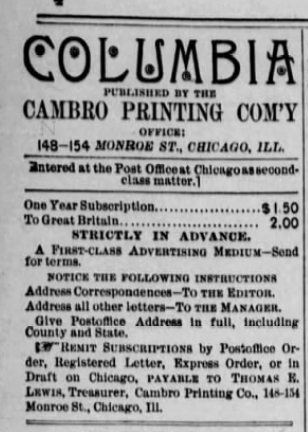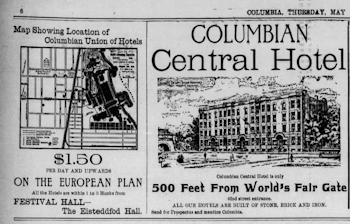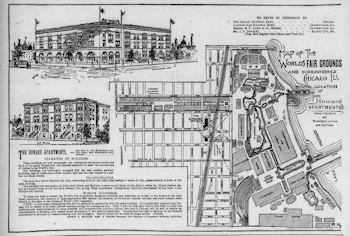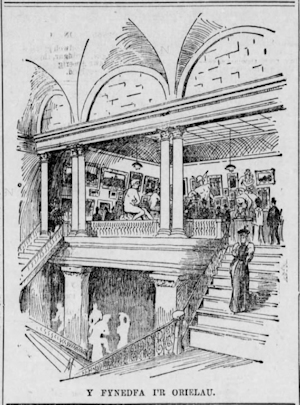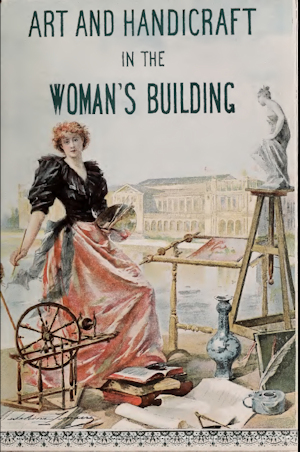
1887 - Josefa Humpal married Robert Zeman on June 30, 1887 in Chicago.
1888 - Josefa Humpal Zeman and Robert Zeman, living in Cleveland, Ohio, are divorced.
1889 - Enrolls at the College for Women of the Western Reserve in Cleveland. (1)
1890 - The Pittsburgh Press, Pittsburgh, Pennsylvania, Friday, November 21, 1890, Page 1 - "Just A Little Headline" - "The convention of the National Non-Partisan Woman's Christian Union will end this evening. . . . . and before going further with the business of the day Miss Josephine Zeman, the earnest little Bohemian worker, was asked to make a statement in regard to the work among the foreigners. Her address was filled with simple eloquence and was one of the most interesting features of the whole meeting. The foreigners who come here are not the good for nothing class that they are generally supposed to be. They are made what they all too often turn out to be by designing politicians. Mrs. Zeman has been working among the people of her race in Cleveland for two years and has had wonderful success. . . . Mrs. Zeman urged upon the women the importance of her work, and asked for prayerful, earnest co-operation on their part. . . "
1892 - Josefa listed as Secretary for the Czech Committee for Preparation Works of Czech Women at the Columbus World's Fair. (2)
1893 - Josefa leaves college and returns to Chicago. She enrolls at the University of Chicago. Josefa becomes a member of the Chicago University Settlement and begins a four year term as a Chicago schools truant officer. Josefa becomes a resident of Hull House. She is elected as the chairperson of Vlasta #19 of Jednota Ceskych Dam Illinois branch (Union of Czech Women).
Josefa Humpal Zeman is listed as a member of the Bohemian Advisory Council Woman's Building at the World's Fair, as well as a guest speaker at one of its evening sessions with the topic of "Woman as a Social Leader". (3)
The Chanute Daily Tribune - Thursday, July 13, 1893, Page 3 - "Mrs. Josefa Humpal Zeman, the Bohemian woman who is now in Chicago, studying up on the working-woman question, states that Bohemian women in teaching receive as high salaries as men for the same work, and that two bohemian papers are controlled and edited by women. Mrs. Zeman herself is a newspaper woman, and has attended personally to all the work in the Bohemian department of the Woman's building at the Fair. . . " (4)
In 1893 an unusual newspaper published an article on the Columbian Exposition. The "Columbia" was a newspaper published by the Cambro Publishing Company in Chicago. (Image below) (Note: While newspapers.com lists the paper's location as Kansas, the full paper, page 1 lists Chicago) It is a newspaper printed in the Welsh language. It has a full page story of the Woman's Building. (View Page in PDF format) It also carried advertisements for hotel accommodations and a map of the Exposition grounds (Images below), but those advertisements are in English.
1894 - Josefa heads the formation of the Zenske Listy newspaper and on June 15, 1894 the first issue of "Women's Letters" is published. The Baltimore Sun on June 27, 1894 reported on Josefa's visit to their city. (5) (View Article in PDF Format)
1895 - Josefa attends Ethnographic Exposition in Prague. She attends and speaks at a meeting held at Chicago's Thalia Hall. Hull House Publication "Hull House Maps and Papers" includes article written by Zeman. (6)
The Chicago Tribune, Chicago, Illinois, Wednesday, January 2, 1895, Page 8 - "All Meet as Sisters" - "It's a gathering of Jednota Ceskych Dam, where the Advancement of the Gentler Sex is Discussed - Bohemians Asked to Work with Americans - Mme. Josefa Humpal-Zemanova, ...... Among the Speakers." Speaking nationally, it was a most delightful Bohemian affair - the meeting yesterday afternoon under the auspices of the Jednota Ceskych Dam, a world wide organization of Bohemian women which in Chicago includes 1,300 members. . . . . . Thalia Hall, where the three hours' session was held, is at Eighteenth and Allport streets, in the midst of a Bohemian settlement. The hall was filled to overflowing with an audience of 2,000 enthusiastic men and women, mostly Bohemians, who were generous in applause as each number of the program was given. . . . . . The meeting was in charge of Mme. Josefa Humpal-Zemaoova, editor of the Zinsky Listy, a Bohemian paper published fortnightly in this city, and a resident of Hull House, who some day hopes to found a Bohemian social settlement. Mme. Josefa Humpal-Zemanova will be remembered for work don in connection with teh Woman's Congresses of the Columbian Exposition. . . . Mme. Josefa Humpal-zemanova spoke briefly in English, saying the Bohemian worm of Chicago stood ready to cooperate in the advancement of woman's work. . . . . "
The Evening Star, Washington, District of Columbia, Monday, February 5, 1895, Page 3 - "Women in Business, The Subject Discussed at the National Council" - ". . . . Before the business of the day was entered upon the privileges of the floor were extended to Madam Josefa Humpal Zeman of Hull House, Chicago, vice president for Bohemia in the International Council of Women. Madam Zeman represents the Union of Bohemian Women, an organization that had its origin in the world's fail congresses of women . . . . She spoke for a more generous feeling toward the foreign element, and told of the efforts made by her Bohemian sisters to achieve the best in American citizenship. She made an earnest plea in favor of the proposition to appoint a secretary for foreign women, holding the opinion that the council being nation in character and not sectarian, was in the best position to reach the foreign element."
1897 - Appointed Executive Secretary of Slavic Journalists. The Twice A Week Messenger, Owensboro, Kentucky, Wednesday, November 24, 1897, Page 5 - "MME. Humpal Zeman - The Able Editor of the Zenske Listy of Chicago_ " Mme. Josefa Humpal Zeman of Chicago, the only bohemian newspaper woman in the country, was homored by the male members of the National Slavic Press Association, which met at Cleveland, Ohio, a few days ago, by being elected secretary of that organization. Being elected to office is not a new novelty to Mme. Zeman, but this is the first time the slavic men have publicly recognized the progressive woman's movement in this county.
This clever woman was at one time a resident of Hull House. She is one of the vice presidents of the international council of women, and at the time of the world's fair was one of the most prominent participants in the woman's congresses.
As editor of the Zensky Listy, which is Bohemian for "Woman's Journal" Mme. Zeman is the acknowledged leader of her country women in the United States. She lives among her people at 561 Blue Island avenue, and her hospitable quarters are really a miniature social settlement. The Zenske Listy is the only paper in the country devoted to Slavic women and was started four years ago.
The honor came as a surprise to me, said Mme. Zeman enthusiastically, and has been heartily received by the Bohemian women. We did not expect to be recognized so soon by the men. I was the only woman delegate to the convention, and when the office was offered me, I declined the homor. Imagine my wonder when the election was made unanimous by a rising vote. It was a great victory for Slavic women of the country, and we are, of course, happy over our unexpected fortune."
1898 - The Chicago Tribune publishes an article on the Bohemian Woman's Literary Club. Josefa Zeman describes the organization. Read the article in PDF format The Chicago Tribune includes an article announcing the publication of a book by Josefa Zeman entitled the "Calendar of Bohemian Women". Read the article in PDF format.
1899 - The Banner Press, David City, Nebraska, Friday, August 11, 1899, Page 7 - "Miss Emma Zerzan, a trained nurse from Chicago, and Mrs. J. Humpal Zeman, editor of the Womens' Journal, a Bohemian publication in Chicago, are out making a tour of the west and visiting friends in Schuyler and other points....."
1900 - The Nebraska State Journal, Lincoln, Nebraska, Sunday, May 6, 1900, Page 10 - "In Chicago there is a publishing house in which all the work from office "girl" to editor and manager is done by women and the necessary capital to run the business is supplied by them. They publish a weekly Bohemian periodical, the Zenske Listy. "As long ago as 1895," says the Chicago Times-Herald, "fifty of the most progressive women in the Bohemian quarter of Chicago formed the Bohemian Woman's publishing company for the purpose of establishing a periodical which should in some adequate way express the aims and ambitions of the Bohemian women in America. In this were to be discussed matters vital to the home, both from the domestic and educational side, the upbringing of children, social problems, current events and literature, and all other questions affecting the destiny of women."
The other Bohemian journalists did not take kindly to the enterprise at first, and endeavored to crush it, but at the end of two years it was so firmly established that opposition gave way and the editor was elected secretary of the Slavic Press association, a body hitherto make up entirely of men."
1901 - The Baltimore Sun, Baltimore, Maryland, Monday, January 28, 1901 - "A Bohemian Woman's Paper" - In an article in the Woman's Home Companion for February, Sibyl Wilbur gives an account of a paper published in Chicago by and for Bohemian women. She says of it:
"This woman's paper was founded by Mrs. Josefa Humpal-Zeman, one of the ablest women of her nationality in this county. Its birth was the result of a trip made by Mrs. Humpal-Zeman, in company with two other Bohemian delegates, to the Columbian World's Fair Congress of Women. These three women, after the congress, visited the various Bohemian settlements throughout the entire United States, talking to their contry women and finding out their needs and aspirations. Mrs. Humpal-Zeman found a hunger among the women for a journal which should tell them all about the doings in the world of women, and to satisfy this desire of her countrywomen she founded her journal. It is to be remembered that this event transpired three years before Madame Marguerite Durand had printed, under the title "La Fronde'" these words, 'A woman's journal for women, the faithful echo of their feelings.'
"Mrs. Humpal-Zeman's paper does not make so strong a bid for the public's attention as does the journal of Madame Durand, for whereas La Fronde is a daily, Zenske Listy, appears only once a week. But to the latter belongs at least the honor of being "the first Bohemian woman's weekly in the world" which is a part of the legend printed on the editorial page of Zenske Listy. The paper first appeared as a monthly; later it appeared as a semi-monthly, and still more recently came out as a weekly. From its founding until a little over a year ago Mrs. Humpal-Zeman was not only its editor, but its owner and manager as well. In the fall of 1899 50 leading Bohemian women from various parts of teh United States banded themselves together in a stock company to own and issue Zenske Listy. The corporation is called "The Bohemia Woman's Publishing Company" and does much work outside of printing the journal."
1902 - The Labor Champion, Topeka, Kansas, Friday, April 11, 1902, Page 6 and same article Appeal to Reason, Girard, Kansas, Saturday, April 5, 1902 - "Paris Workingmen" - ". . . . . Unskilled labor in this city gets an average wage of about 3 1/2 francs ($2) a day. . . . . Children are taken out of school at an early age to enter trades as apprentices or to help their parents in their trades. This is especially true in families of grocers and butchers. Girls frequently go to school only two hours a day. . . . . The food of the workingman consists mainly of huge quantities of coarse bread, diluted wine and cheap vegetables. for breakfast he has nothing but coffee, made mostly of chicory, and bread. . . . ." From Paris - Josefa Humpal Zeman.
1903 - Thomas Capek, author of "The Cechs in America", 1920, Houghton Mifflin Company, The Riverside Press Cambridge, Boston, notes that in 1903, in Prague, Josefa published a book, "Amerika v pravem svetle", America in its True Light. On page 7 of his introduction, he indicates that Josephine Humpal-Zeman is a friend and acquaintance. On pages 201 and 202 he gives a good description of the life of Josefa and the publication of her new book.
Editors Schultz and Hast describe that editors of Bohemian publications in the United States worked to prevent it from being offered in the United States. The Editors also describe that she visited her sister in Chicago in 1903. That year would be the last time she would be in the United States. (7)
1904 -The Oshkosh Northwestern - Oshkosh, Wisconsin - Saturday, February 13, 1904, Page 2 - "Women of Bohemia - Mrs. Humpal Zeman Talks of Tour Through Native Country." - Mrs. Josefa Humpal Zeman beloved and admired of Chicago Club women, is back in Chicago after two years spent in the study of sociological conditions and problems, the woman question and the public schools of Europe. Mrs. Humpal Zeman left Chicago in November, 1901, returning a few days ago.
Mrs Humpal Zeman will be remembered as the founder and original owner of Zenske Listy, the "woman's paper" which published in the "Little Bohemia" of Chicago, antedated the more famous and pretentious Parisian La Fronde by more than three years. This paper, still flourishing, though for some time owned and published by a stock company of Bohemian women, was from the very first a "woman's paper" in several senses. It was owned and controlled by a woman, and womanly fingers performed every task about it, from the work of the managing editor to that of the "printer's devil." Tea was served to every employe of the journal every afternoon, beginning with the intial day of the combined effort. First appearing in 1894, Zenske Listy was owned and controlled by Mrs. Humpal Zeman until 1900. The management of this, the first actual "woman's paper" to be published represents but a small part of the successful and valuable work of this clever and charming woman who later returned to her own land, Bohemia, to find that a pleasant literary reputation of which she was quite unconscious, had preceded her.
An experimental social worker, at one time prominently connected with Hull House, Mrs. Humpal Zeman thrills with interest over the fact that the first social settlement in Europe, contrary to public belief and opinion, was started in Bohemia as far back as 1860. Mrs. Josefa Naprstkova, famous as a labor leader and authority, still maintains this center with the aid of a board of trustees. She and her husband threw open their quaint and historical house, situated in the famous "Betiems Ry Placek" where the great reformer Jan Huss, performed his mighty work in the fourteenth century, to their friends and neighbors many years ago. The fine library was open to women on certain days of the week, to scholars and workingmen on others; playgrounds and a library for children were opened by the same devolted couple, lectures for the masses started and the first Bohemian women's club set going. This club was name by its founders the "American Women's club," because it was hoped that members would follow the example of the American women in progress and accomplishment.
Bohemian club women are very practical and progressive, according to Mrs. Humpal Zeman, the latent club movement being the inaugurating of a woman's club based on the the same general plan as the Woman's club of Chicago, although on a smaller scale. Mrs. Humpal Zeman took with her to Europe photographs of most of the large women's clubhouses and rooms in America, and found that not only European women but European men were interested in this exhibit. She enjoyed also the peculiar distinction of being the first women ever invited to deliver paid lectures to audiences of both sexes. She lectured through Bohemia, Moravia and European Silesia. Three of her most popular lectures were published under the title of "America in True Light."
"I found European men greatly interested in all the subjects that most interest me," said Mrs. Humpal Zeman, "and they were particularly delighted to find that I still liked "womanly matters. European women, you know, frequently become very masculine when they take to letters or learning. I was careful to wear lace gowns and other distinctively feminine articles of apparel when lecturing, in order to strengthen the impression that in America women may follow literary times, yet still remain quite feminine. It is difficult for Europeans to realize how it is that American women may sustain successful and pleasant family relations, yet still have outside work that calls for much time and effort. The European mind, indeed, finds it almost impossible to understand American ways and conditions. Persisting in regarding us as English, they are sadly hampered in their initial conceptions of our ways and country. One of the greatest differences noticeable between American and European club women lies in their tendency to philosophize endlessly before beginning actual operations. Here, as I told them, we first do something, and indulge in philosophizing, if this seem necessary, later on."
But the ignorance of many Europeans in regard to America, Mrs. Humpal Zeman admits with a smile, is but little more pronounced than the ignorance of many Americans in regard to Bohemian work and accomplishments.
"One woman," she explained, "asked me many questions the other day about my winter in Italy, my social studies in France, my public school investigations in Switzerland, my Alpine climbing, the fine collections of little known and picturesque peasant costumes, laces and lantern slides I have brought back with me, my visits to the home of Kubelik, Pere and Mme. Hyacinth, and similar interesting experiences, and finished by calmly inquiring; life in Bohemia? Is classical music at all appreciated there?
"I could not but smile as I recalled the fact that musical students from all over the world, America, Europe, New Zealand, Hawaii, Australia, are flocking to Prague to study with Kocian, the great Kubelik's teacher, and with the other famous musicians and teachers congregated there. Kubelik himself, Dr. Anton Dvorak, the famous composer Ondricek and many other musical stars hail from Bohemia - which, indeed, is the gem of Austria, having the best of everything, from coal mines to the famous Prague university and equally famous Minerva preparatory school for girls, within its confines. It is the same way with the arts, art crafts, the social problems and questions of the moment, the various socialistic and national movements and, in fact, all the stirring and important matters of the time. A list of famous Bohemians would include many names generally credited to other countries together with much valuable work of many kinds and orders.
"Aljons Mucha, who makes all the designs, posters and scenery used by Bernhardt is a Bohemian; so are Dedina, Krup Ka and Vaclav Reozik, whose picture of Christopher Columbus before Ferdinand and Isabella was reproduced on the five cent Columbian postage stamp."
 Mrs. Humpal Zeman will deliver a number of illustrated lectures during the winter, her trip through the Carpathian mountains on foot and her visit to Bavaria being favorite subjects. - Chicago Record Herald."
Mrs. Humpal Zeman will deliver a number of illustrated lectures during the winter, her trip through the Carpathian mountains on foot and her visit to Bavaria being favorite subjects. - Chicago Record Herald."
Josefa Humpal Zeman is listed as the executive secretary of the women's club in Prague.
Josefa Humpal Zeman establishes (as founder) the "Stastny Domov" (Happy Home), newspaper in Prague. The paper is first published on October 1, 1904.
1905 - The obituaries published by the "Statsny Domov" indicate that on April 7, 1905, in Prague, Josefa suffers a career ending medical condition.
 1906 - Czech newspaper, "Statsny Domov", founded by Josefa reports that Josefa died on April 23, 1906. Image left is the funeral procession picture from the May 1, 1906 edition of the "Statsny Domov".
1906 - Czech newspaper, "Statsny Domov", founded by Josefa reports that Josefa died on April 23, 1906. Image left is the funeral procession picture from the May 1, 1906 edition of the "Statsny Domov".
It seems that no Chicago based Bohemian papers carry the news of Josefa's death. On May 2, 1906, the "Pokrok Zapadu", Bohemian language newspaper of Omaha, Nebraska, listed her death on Page 3. The article included a short summary of her life, her burial in Olsany Cemetery in Prague, and listed she had a sister and brother in Chicago.
References:
(1) "Women Building Chicago 1790 - 1990", Editors Rima Lunin Schultz, Adele Hast, Indiana University Press, 2001, Pages 417 - 420.
(2) Thesis - Ondruskova, Andrea, "Between Two Worlds: The Women's Letters Magazine and the Life of Czech Women in America in 1894-1901". Prague, 2012. 109 pp. Diploma Thesis (Mgr.) University, Charles University, Faculty of Social Sciences, Institute of Communication Studies and Journalism, Department media studies. Thesis supervisor Doc. Ph Dr. Barbara Köpplová, CSc. Pages 57 - 58.
(3) "The Congress of Women, Held in the Woman's Building, World's Columbian Exposition", Editor Mary Kavanaugh Oldam Eagle, Western W. Wilson Publishers, New York, 1894.
(4) "Notes", "The Chanute DailyTribune", Chanute, Kansas, Thurday, July 13, 1893, Page 3.
(5) " Mrs. Humpal Zeman", "The Baltimore Sun", Baltimore, Maryland, June 17, 1894, Page 8.
(6) "Hull House Maps and Papers" by Residents of Hull House, Publisher Thomas Y. Crowell, Boston, 1895, Pages 115 to 130.
(7) "Women Building Chicago 1790 - 1990", Editors Rima Lunin Schultz, Adele Hast, Indiana University Press, 2001, Pages 417 - 420.

